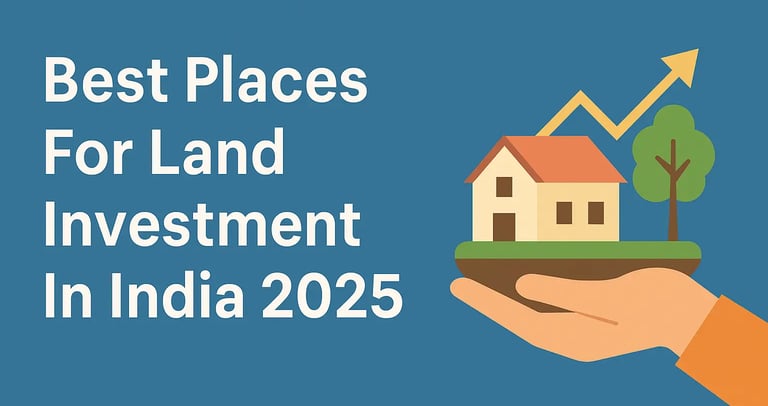Best Places For Land Investment In India 2025
Explore the top places for land investment in India 2025 with our guide, covering metro corridors, industrial hubs, and growth zones for long-term wealth.
Archita
4/5/20255 min read


Land is the only thing they’re not making anymore.
Investing in land has long been one of the most secure and rewarding forms of investment. With India’s rapid urbanization, expanding infrastructure, and government initiatives geared toward economic growth, land investment opportunities in 2025 are expected to shine. In this comprehensive guide, we explore the best places for land investment in India in 2025, key factors to consider, regional highlights, and even take a closer look at the Bangalore housing market before wrapping up with a conclusion and frequently asked questions.
Why Invest in Land in India?
Land is a finite resource, and as the saying goes, “land is the only thing they’re not making anymore.” In India, this principle holds true, especially in the face of urban sprawl and evolving economic policies. Here are a few reasons why investing in land is a smart move:
Appreciation Potential: Historically, land investments in emerging areas have yielded annual returns in the range of 5-8%. As cities expand and new infrastructure projects are implemented, the value of land is poised to appreciate even further.
Lower Entry Cost: Compared to built-up properties, raw land generally requires a lower upfront investment. This makes it accessible to a wider range of investors.
Flexibility: Land can be used for various purposes—residential, commercial, or industrial—depending on zoning regulations and future development plans.
Hedge Against Inflation: With increasing construction costs and rising demand for housing and commercial spaces, land prices often outpace inflation, providing long-term security for your investment.
Key Factors to Consider When Investing in Land
Before diving into the best locations, it’s important to understand the factors that affect land investment in India:
Location and Connectivity: Proximity to major highways, metro lines, airports, and upcoming infrastructure projects can drive up land value.
Zoning and Regulatory Environment: Ensure that the land’s zoning regulations align with your intended use. Special Investment Regions (SIRs) and Special Economic Zones (SEZs) often come with attractive tax and regulatory incentives.
Development Potential: Look for areas with planned urban development, smart city initiatives, or industrial corridors, as these regions are more likely to witness rapid appreciation.
Government Policies: Recent reforms and government schemes (like RERA, Smart Cities Mission, or DMIC projects) can significantly influence land prices.
Environmental and Social Factors: Assess factors such as water availability, soil quality, and community development plans, which can impact the long-term viability of the investment.
Top Regions for Land Investment in India in 2025
India’s diverse geography offers a plethora of investment opportunities. Here’s a look at some of the most promising regions:
Tier-I Cities and Metropolitan Corridors
Bangalore: Known as the Silicon Valley of India, Bangalore’s tech boom and ongoing infrastructural improvements have pushed land prices upward. Areas on the city’s outskirts, especially along emerging corridors like Whitefield and Sarjapur Road, are attracting significant interest.
Mumbai: As India’s financial capital, Mumbai’s limited land availability and high demand for commercial spaces make any available land highly valuable. Suburban areas around Mumbai, such as Navi Mumbai and Thane, offer potential growth.
Delhi NCR: With its vast urban sprawl, areas in Gurgaon, Noida, and Greater Noida continue to offer strong appreciation potential. The region’s connectivity and job opportunities fuel demand for both residential and commercial land.
Pune: Pune’s blend of academia, IT, and manufacturing sectors provides a balanced ecosystem for land investment. Regions around Hinjewadi and Kharadi are particularly attractive due to planned infrastructure projects.
Tier-II and Emerging Cities
Hyderabad: Known for its affordability and robust IT sector, Hyderabad is emerging as a hotspot for land investments. Areas around Gachibowli, Hitech City, and the outskirts are ripe for development.
Ahmedabad: With a strong industrial base and the recent push under the Smart City Mission, Ahmedabad’s land is becoming increasingly valuable. Investment in the suburban fringes of the city offers promising returns.
Jaipur and Lucknow: These cities are witnessing rapid urbanization, driven by a young demographic and improving infrastructure. Land in the outskirts of Jaipur and Lucknow is expected to appreciate significantly over the next few years.
Indore: As one of the fastest-growing cities in central India, Indore offers attractive land prices with substantial potential for long-term growth.
Industrial Corridors, SEZs, and Special Investment Regions
Government-led initiatives have created several investment hubs across the country:
Dholera Special Investment Region (DSIR): Situated in Gujarat, DSIR is one of India’s largest greenfield projects. Its strategic location along the DMIC corridor, coupled with favorable tax incentives, makes it a prime location for land investment.
Aurangabad Industrial City (AURIC): Part of the Delhi-Mumbai Industrial Corridor (DMIC), AURIC offers tremendous potential, especially for industrial and commercial land investments. Its large-scale infrastructure and smart city features are major draws.
KRIS City: Located in Andhra Pradesh, KRIS City is designed as an industrial hub with a focus on advanced technology and manufacturing. Investment in land here is expected to grow as the city evolves.
Dholera SIR: Spread over a massive area in Gujarat, the Dholera Special Investment Region is set to become a major industrial and financial hub, offering significant land appreciation potential.
Bangalore Housing and Land Investment
Before we wrap up, it’s essential to zoom in on Bangalore, a city synonymous with technological advancement and urban growth. While much of the conversation around Bangalore focuses on its residential and commercial property market, land investment in the city is equally compelling.
Bangalore’s rapid expansion has pushed the city’s boundaries outward. The burgeoning IT sector, combined with extensive infrastructural projects such as the Namma Metro’s expansion, has created new growth corridors on the city’s outskirts. Areas like Whitefield, Sarjapur Road, and North Bangalore are witnessing increasing demand for land, driven by both residential development and industrial parks.
Moreover, as the city evolves, the differentiation between land for housing and land for commercial use is becoming blurred. Investors are now looking at large tracts of land that can be developed into integrated townships or gated communities—thereby addressing the rising demand for quality housing in a planned environment. This trend not only enhances the value of the land but also provides an opportunity for substantial returns in the long term.
Bangalore housing dynamics serve as a microcosm of the broader land investment landscape in India, where strategic planning, robust infrastructure, and an ever-growing population create a conducive environment for land appreciation.
Conclusion
Overall at the end, land investment in India in 2025 offers diverse and lucrative opportunities across both Tier-I and Tier-II cities as well as emerging industrial corridors and special investment regions. Whether you’re eyeing the metropolitan vibrancy of cities like Bangalore, Mumbai, and Delhi NCR or the untapped potential in Hyderabad, Ahmedabad, Jaipur, and Indore, careful consideration of location, infrastructure, government policies, and future development plans is key. With smart planning and due diligence, land investment can serve as a solid foundation for long-term wealth creation and financial security.
Frequently Asked Questions (FAQs)
Q1. Why is land investment considered a safe bet in India?
A1. Land investment is often safer because land is a finite resource, tends to appreciate over time, and is less susceptible to market volatility compared to built-up properties.
Q2. Which regions in India are best for land investment in 2025?
A2. Promising regions include metropolitan corridors around Bangalore, Mumbai, Delhi NCR, and emerging cities like Hyderabad, Ahmedabad, Jaipur, Lucknow, and Indore. Additionally, industrial corridors like DSIR, AURIC, and KRIS City are attractive.
Q3. What factors should investors consider when choosing a location for land investment?
A3. Key factors include connectivity, zoning and regulatory environment, planned infrastructural development, government initiatives, and the potential for future urban expansion.
Q4. How does the Bangalore housing market influence land investment opportunities?
A4. Bangalore’s rapid urban expansion, driven by IT growth and infrastructure projects, is pushing the city’s boundaries outward. This creates high demand for raw land in peripheral areas, offering significant potential for future residential and commercial development.
Q5. Are government initiatives playing a role in boosting land investment?
A5. Yes, initiatives like the Smart Cities Mission, DMIC, and the establishment of SEZs and SIRs provide regulatory incentives and infrastructural support, which significantly boost the appeal of land investments.
Bengaluru Housing
Explore Bengaluru's housing market through insightful articles.
subscribe us
© 2025. All rights reserved.
